Radiator Valves Explained - The Ultimate Guide
Posted by Radiator Valves 4u on 16th Oct 2025
Key Takeaways
- What they do: Radiator valves control the flow of hot water into your radiator, which allows you to manage the temperature of a room.
- The two-valve system: Most radiators have a control valve (which you adjust) and a lockshield valve (which is for professional system balancing and should be left alone).
- Types of radiator valve: Your main choice is between manual valves (simple on/off control) and thermostatic radiator valves (TRVs), which automatically sense the room temperature to improve comfort and save energy.
- Which shape?: The valve's orientation must match your pipework:
- Angled valves are for pipes from the wall or floor.
- Straight valves are for pipes that run directly into the bottom of the radiator.
- Radiator valve size: The vast majority of homes in the UK use 15mm pipes, so 15mm valves are the standard choice.
- Best for savings: Upgrading from manual valves to TRVs is one of the most cost-effective ways to reduce your heating bills and improve comfort.
In the world of home heating, the humble radiator valve is a true unsung hero. It’s a small component, often overlooked, yet it holds the key to your comfort, your energy bills, and even your home’s interior style. These crucial fittings are the gatekeepers of warmth, diligently controlling how much heat enters each room.
In this comprehensive guide, we’ll talk about all things radiator valves. We’ll explain the fundamentals of how radiator valves work, explore the different types available, show you how to choose the right size and style for your heating system, and even offer practical advice on installation, adjustment, and maintenance. By the end, you’ll be an expert, ready to choose the perfect valves for your home!
First Things First: What Are Radiator Valves?
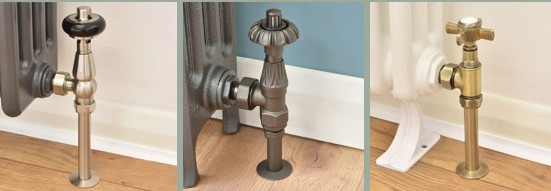
Before we go too far, let’s address an important first question: just what are radiator valves? In simple terms, they are devices that control the flow of hot water from your central heating system into your radiator. By adjusting the valve, you control the radiator's temperature and, consequently, the warmth of the room.
Choosing the right valves is more important than you might think. The correct choice can lead to significant savings on your energy bills, allow you to create perfectly tailored heating zones throughout your home, and provide the ideal finishing touch to your radiators and overall decor.
How Radiator Valves Work: The Fundamentals
Understanding how a radiator valve works is the first step to mastering your home heating. While the technology can vary, the basic principle is refreshingly simple.
The Basic Mechanism: Controlling Water Flow
At its core, a radiator valve functions much like a tap. Inside the valve body, there is a small internal pin or gate. When you turn the valve head, this pin moves up or down. As the pin rises, it opens the valve, allowing more hot water from your central heating system to flow into the radiator. Conversely, as it lowers, it restricts the opening, reducing the flow of hot water.
This relationship between water flow and heat output is direct and simple:
- More hot water flowing into the radiator = a hotter radiator and more heat output.
- Less hot water flowing into the radiator = a cooler radiator and less heat output.
By controlling this flow, you are in complete command of each radiator’s temperature, independent of the others in your home.
Understanding Your System: Inlets, Outlets, and Pipe Centres
Your central heating system is a circuit. Hot water leaves your boiler, travels through pipes to your radiators, and then returns to the boiler to be reheated.
- Inlets and outlets: Each radiator has two connections. The inlet (or flow) pipe brings hot water into the radiator. The outlet (or return) pipe carries the now cooler water out of the radiator and back towards the boiler. The control valve (manual or thermostatic - more on that later!) is typically fitted to the inlet pipe.
- Pipe centres: This is the measurement of the distance between the two pipe inlets on your radiator. This is a crucial measurement when you are considering specific types of modern radiators, especially those with underside connections, which often require a specific valve type (like an H-Block valve) with fixed pipe centres of 50mm.
- Pipe systems: The vast majority of modern homes in the UK use a two-pipe system, where the flow and return pipes are separate circuits. This is the system this guide focuses on, as it's the standard for which all our valves are designed.
What are the two valves on a radiator for?
One of the most common questions we hear is why radiators have two valves. While they might look similar, they perform two very different and distinct roles to ensure your heating system works efficiently.
Valve 1 - the control valve: This is the valve you will interact with. It’s fitted on the inlet pipe and is designed to control the temperature of the radiator. This will either be a manual radiator valve, which you turn to adjust the heat, or a thermostatic radiator valve (TRV), which automatically adjusts the heat based on the room's temperature. This is your day-to-day temperature controller.
Valve 2 - the lockshield valve: The second valve, found on the outlet pipe, is called the lockshield valve. Its purpose is crucial but hands-off for the homeowner. It’s used by a heating engineer to perform a process called "balancing". Balancing involves adjusting the lockshield on each radiator to ensure that hot water is distributed evenly throughout the entire house. This prevents radiators closest to the boiler from getting all the heat while those further away remain cold. Once set by an installer, the lockshield is covered with a cap and should not be adjusted.
A Complete Guide to the Different Types of Radiator Valves
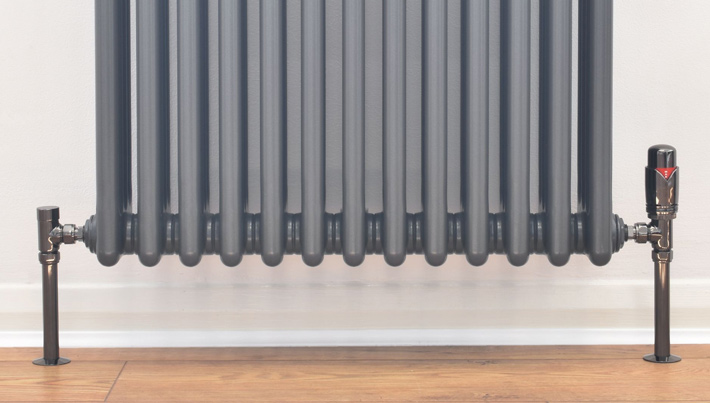
Radiator valves can be categorised in two main ways: by their function (how they control the heat) and by their orientation (how they physically connect to your pipes and radiator). This section focuses on the different functions.
Radiator Valve Types: At a Glance
To help you understand the key differences, here is a quick comparison of the main functional types of radiator valves.
|
Valve Type |
Primary Function |
Best For |
Key Benefit(s) |
Potential Drawback(s) |
|
Manual |
Simple on/off and flow control. |
Rooms with stable temperatures, bathrooms, hallways, budget-conscious projects. |
Low cost, simple to use, reliable. |
Inefficient, requires manual adjustment, no automatic temperature control. |
|
Thermostatic (TRV) |
Automatic temperature regulation. |
Living rooms, bedrooms, main living areas where temperature control is desired. |
Energy savings, room-by-room temperature control, convenience. |
Higher initial cost, shouldn't be used in rooms with a wall thermostat. |
|
Lockshield |
System balancing. |
The outlet side of every radiator in a two-pipe system. |
Ensures even heat distribution across the property. |
Not for user adjustment. |
|
Dual Fuel |
Allows radiators (esp. towel rails) to be heated by mains electricity. |
Bathrooms, kitchens. |
Year-round heating without turning on the central heating system. |
Requires electrical installation (T-piece element). |
Manual Radiator Valves
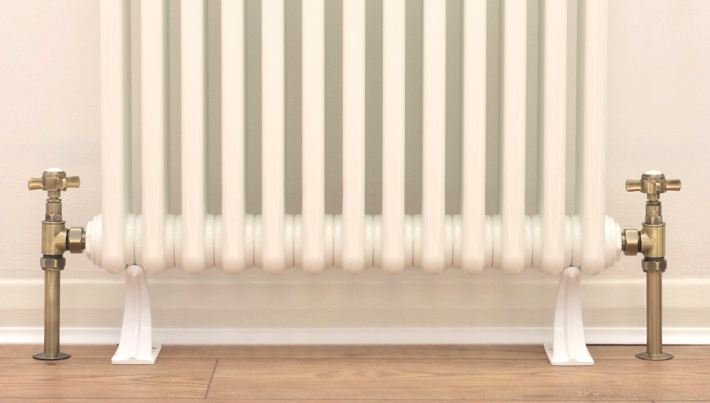
Manual valves are the simplest type of radiator valve. They work just like a tap: you turn the head to manually open or close the valve, increasing or decreasing the amount of hot water entering the radiator.
Pros and Cons of Manual Radiator Valves:
- Pros:
- Simplicity: They are incredibly easy to understand and operate.
- Durability: With fewer moving parts than a TRV, they are very reliable and long-lasting.
- Lower cost: Manual valves are typically the most budget-friendly option.
- Cons:
- Lack of efficiency: They do not react to changes in room temperature. If the sun comes out and heats the room, a manual valve will keep pumping heat out, wasting energy.
- Requires constant adjustment: To change the room's temperature, you must physically go and turn the valve yourself.
Explore our range of manual radiator valves
Thermostatic Radiator Valves (TRVs)
Thermostatic Radiator Valves (TRVs) are the smarter way to control your heating. They have a built-in sensor, typically a small capsule containing wax or liquid, that expands or contracts in response to the room's temperature. This sensor operates a pin inside the valve body, automatically adjusting the water flow to maintain your desired temperature.
What do the different numbers on TRVs mean?
The numbers on a TRV correspond to a specific temperature setting, giving you precise control over each room. While the exact temperatures can vary slightly by manufacturer, this is a reliable guide:
- * (Frost Protection): Approx. 7°C. This setting allows a minimal amount of water to flow if the temperature drops close to freezing, preventing pipes from freezing and bursting.
- 1: Approx. 10°C
- 2: Approx. 15°C
- 3: Approx. 20°C (Generally considered a comfortable room temperature)
- 4: Approx. 25°C
- 5: Fully open (Maximum heat output)
Do Thermostatic Radiator Valves Save Money?
Yes, absolutely. By preventing rooms from overheating and allowing you to set lower temperatures in unused areas, TRVs are a proven way to reduce energy consumption - using them effectively can be a key part of reducing your heating bills. They give you room-by-room "zoning", meaning you're not paying to heat an empty bedroom to the same temperature as your living room.
Pros and Cons of Thermostatic Radiator Valves:
- Pros:
- Energy efficiency & cost savings: The primary benefit. They significantly reduce energy waste.
- Convenience: "Set and forget" operation maintains your desired comfort level automatically.
- Comfort: Eliminates hot and cold spots, providing consistent warmth.
- Cons:
- Higher price: The initial cost is higher than for manual valves.
- Environmental factors: They can be affected by draughts or direct sunlight, which may cause them to give inaccurate readings. They also shouldn't be blocked by furniture or thick curtains, as this traps heat and causes the TRV to shut off prematurely.
Browse our collection of thermostatic radiator valves
Changing Manual Valves for Thermostatic Radiator Valves
Upgrading from manual valves to TRVs is one of the most popular and cost-effective heating upgrades you can make. It’s a relatively straightforward job for a plumber and the return on investment through energy savings makes it a very worthwhile project.
Specialist Radiator Valves
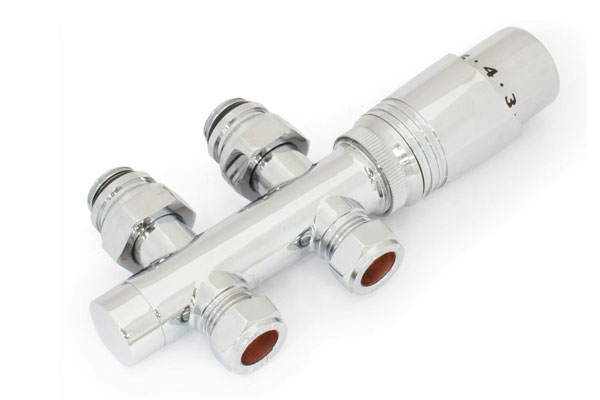
Beyond the more standard types, some valves are engineered for specific applications or to solve common installation problems. This includes products like:
SureSeal Radiator Valves
Designed to provide a guaranteed, worry-free seal, these valves are a fantastic choice for reliability. They use a unique cone shape and EPDM rubber construction to ensure an optimal fit and a lasting, superior seal. The "SureSeal" technology drastically reduces the risk of leaks, offering peace of mind after installation.
Towel Rail Radiator Valves
While any compatible valve can be used on a towel rail, specialist towel radiator valves are designed to offer a more stylish and practical finish in a bathroom setting. Available in a wide variety of finishes, such as chrome, black, white, and anthracite, they’re designed to perfectly match your towel rail and other bathroom fittings.
Like standard valves, they come in both manual and thermostatic (TRV) options to control temperature and improve energy efficiency. Their designs are often more compact or stylised to complement the look of modern or traditional heated towel rails.
Shop from our range of specialist radiator valves
Radiator Valves by Orientation & Size
Once you’ve decided on the function you need (manual or thermostatic), the next crucial step is to choose a valve with the correct physical shape, or orientation, to match your pipework.
Finding the Right Fit: Angled, Straight, Corner, and H-Block Valves
Choosing the right orientation is essential for a neat and efficient installation.
Angled Valves
Angled radiator valves are the most common type in the UK. They connect the pipe and the radiator at a 90-degree angle. You need angled valves if your pipes come out of the wall or up from the floor.
Straight Valves
As the name suggests, straight radiator valves have no bends, with water flowing straight through them. You need straight valves if your pipes run horizontally along the wall or vertically up from the floor directly into the bottom of the radiator.
Corner Valves
Corner radiator valves are a stylish and practical alternative to angled valves. The valve head sits on top, facing inwards and parallel to the wall, rather than projecting out into the room. This creates a much neater, more compact finish, perfect for minimalist spaces or where a standard angled valve might get knocked.
H-Block Valves
Also called twin radiator valves, H-block valves are specialist, all-in-one valves designed for radiators with underside connections, where both the flow and return inlets are at the bottom. They are very neat and have fixed pipe centres of 50mm, matching the standard on these radiator types.
Understanding Radiator Valve Sizes
The "size" of a radiator valve refers to the diameter of the pipe it connects to.
In the UK, the standard size for domestic copper pipes connecting to radiators is 15mm. Therefore, the vast majority of radiator valves you will see for sale are 15mm.
Other pipe sizes such as 10mm, and 22mm do exist in some systems. If you have different-sized pipes, you don't necessarily need a specialist valve. Instead, you can use a simple fitting called an adaptor to connect a standard 15mm valve to your pipework.
Choosing a Radiator Valve Style: Designs, Materials & Colours
Gone are the days when radiator valves were purely functional. Today, they are a key decorative element that can finish off the look of your radiators and contribute to your overall interior design scheme.
Designs & Styles
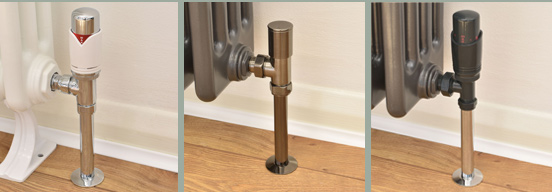
- Traditional/classic: For period properties or classic decor, traditional valves are a perfect choice. Look for features like crosshead or wheel-head handles, often in timeless finishes.
- Modern/contemporary: For modern homes, the focus is on clean lines and minimalist shapes. Look for sleek, simple designs with a smooth, uncluttered profile.
Colours & Finishes
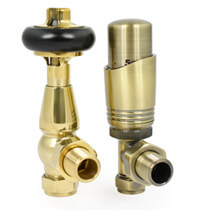
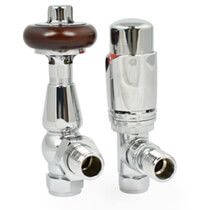
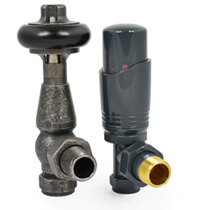
The range of available finishes is vast, allowing you to create a truly cohesive look. Popular options include:
- Polished Chrome
- Nickel (including Satin, Polished, Brushed, or even Black Nickel)
- Brass (including Antique, Polished, Unlacquered, and Old English)
- White
- Black
- Pewter
- Copper
- Anthracite (a dark grey, perfect for matching modern radiators)
Our advice is to either match your valves to your radiator for a subtle, integrated look, or match them to other metal fixtures in your room, such as light switches, sockets, and door handles, for a coordinated design.
The Ultimate Radiator Valve Buying Guide
With so much choice available, here’s how to narrow down the options and find the perfect valves for your heating system.
What to Think About When Buying Radiator Valves
Use this checklist to ensure you cover all the bases:
- Function: Do I need automatic temperature control (thermostatic) or simple on/off control (manual)?
- Orientation: Do my pipes come from the wall/floor (angled) or run straight into the radiator (straight)? Do I want a neater look (corner)?
- Pipe size: Do I have the UK standard 15mm pipes?
- Radiator type: Is it a standard radiator, or a designer model with underside connections that might need an H-Block valve?
- Style & finish: What look am I going for? Should it match the radiator, the taps, or the light switches?
- Budget: What is my price range?
What Radiator Valves Should I Buy? A Scenario-Based Guide
|
Your Goal / Room |
Recommended Valve Type |
Key Considerations |
Suggested Style |
|
Maximum energy savings in a living room/bedroom |
Thermostatic (TRV) |
Choose a reliable brand; ensure it's not blocked by curtains or furniture. |
Modern or Traditional to match your decor. |
|
A statement designer radiator in a modern kitchen |
Corner or H-Block TRV |
The orientation is key to a minimalist look. Match the finish to the radiator. |
Minimalist (e.g., Chrome, Anthracite, Black). |
|
A traditional towel rail in a classic bathroom |
Manual |
Bathrooms are often warm/humid; a TRV can shut off when you want heat. |
Traditional crosshead (e.g., Antique Brass, Chrome). |
|
A simple, functional radiator in a hallway/utility room |
Manual |
Precise temperature control is less critical in these transient spaces. |
Simple, functional, and budget-friendly. |
|
Year-round towel drying without central heating |
Dual Fuel Valve Kit |
You will need a compatible towel rail and an electric heating element. |
Chrome is the most common and versatile finish. |
A Practical Guide to Radiator Valve Installation, Adjustment & Maintenance
Once you’ve picked out your perfect radiator valves, it’s time to get them installed! In this section, we’ll tell you everything you need to know about installing radiator valves, plus we’ll share a few tips to help you keep them performing at their very best.
Disclaimer: While we provide this information to help you understand the processes involved, we strongly recommend hiring a qualified and Gas Safe registered plumber for any installation or major changes to your central heating system. Working on your heating system involves water and high temperatures, and mistakes can be costly - and dangerous.
How to Install & Change a Radiator Valve
Here is a simplified overview of the steps a professional would take to change a radiator valve:
- Drain the system: The central heating system is turned off and partially or fully drained of water to below the level of the radiator being worked on.
- Remove the old valve: The old valve is carefully disconnected from both the pipework and the radiator.
- Fit the new valve: The new valve is fitted. The installer will use PTFE tape on the valve threads to create a secure, watertight seal.
- Refill & pressurise: The system is slowly refilled with water (and inhibitor to prevent corrosion), and repressurised to the correct level.
- Bleed the radiators: The installer will bleed all the radiators in the house to remove any air that entered the system during the work, ensuring they all heat up correctly.
- Check for leaks: A thorough check is performed to ensure all new connections are perfectly sealed.
How to Set, Adjust, and Turn Off Radiator Valves
- Setting TRVs: To find the right temperature for you, start by turning the TRV to a middle setting (e.g., '3'). Leave it for an hour or so and see how the room feels. If it’s too warm, turn it down a notch. If it’s too cold, turn it up. Once you find your comfort level, you can leave it there.
- Adjusting manual valves: This is nice and simple. Turn the valve anti-clockwise to open it and increase heat. Turn it clockwise to close it and reduce heat.
- Should radiator valves be fully open? For TRVs, no. They should be set to the number that corresponds to your desired temperature. For manual valves, it depends on the room. It’s often a good idea to turn them down in lesser-used rooms like guest bedrooms. Be cautious about turning valves off completely in winter though, as this can increase the risk of your pipes freezing.
- How to completely turn off radiator valves: To temporarily isolate a radiator for decorating, turn the control valve clockwise until it stops. For a TRV, this will be the '0' or '*' setting. You must also close the lockshield valve on the other side by removing the plastic cap and using a spanner to turn the spindle clockwise until it stops. Remember to count the number of turns so you can open it by the exact same amount later to keep the system balanced.
How to Maintain Radiator Valves
Radiator valves are generally very low maintenance, but one common issue can occur with TRVs. The small internal pin can sometimes get stuck in the 'closed' position after a long period of inactivity (e.g., over the summer).
To prevent this, it’s good practice to turn your TRVs from the fully closed position to the fully open position a few times during the summer months. This keeps the pin moving freely. If a pin does get stuck, it can often be freed with a gentle tap or by carefully gripping it with a pair of pliers and pulling it up.
To help you keep your radiator valves in tip top condition, we also supply a great range of ancillary products, like replacement TRV heads, radiator heating elements, auto bypass valves, and central heating system additives.
Browse our collection of radiator accessories today!
Buy Your Perfect Radiator Valves at Radiator Valves 4u
Now that you're armed with all the knowledge you need, you're ready to make the perfect choice. At Radiator Valves 4u, we offer one of the UK's most extensive ranges of radiator valves, covering every type, orientation, style, and finish you could possibly need, alongside a comprehensive range of complementary radiator pipe covers and other accessories.
Whether you're upgrading to energy-saving TRVs or searching for the perfect traditional brass valve to complete your period renovation, we have the solution. Our team of experts is dedicated to helping you find the right product, and with fast UK delivery, you can get your project finished sooner.
Browse our full collection of radiator valves today and take control of your home’s heating. Need expert help and advice? Contact our friendly team on 02393 162 901 today.
Radiator Valves Explained: FAQs
What are traditional or old radiator valves?
Typically, these are manual valves, often with a simple wheel-head or capstan-style handle. While they can be aesthetically pleasing, they do not offer the automatic temperature control and efficiency of modern thermostatic valves.
How do I know which radiator valves I need?
Check out our buying checklist above for more information, but essentially: start by checking your pipe direction to determine the orientation (angled, straight, etc.). Next, decide if you need automatic temperature control (TRV) or simple manual control. Finally, choose a style and finish that matches your decor.
What size of radiator valve do I need?
The vast majority of UK homes use 15mm pipework for radiators, so a 15mm valve is almost always the correct choice. However, if you have non-standard pipes, you can use a reducer. If you are unsure, consult a plumber.
Should I get thermostatic or manual radiator valves?
For main living areas like bedrooms and living rooms where you want to control temperature precisely and save energy, choose thermostatic (TRV). For bathrooms or hallways where you want consistent, simple heat, manual is a great, reliable option.
Can I replace a radiator valve by myself?
While it is possible for experienced and confident DIYers, replacing a radiator valve can be a relatively complex job that involves draining your heating system. We strongly recommend hiring a qualified plumber to ensure the work is done correctly, safely, and without leaks.
Why is my radiator valve leaking?
Common causes of a leaking valve include the packing gland nut being loose, worn-out internal seals (known as O-rings), or corrosion over time. A minor leak from the gland can sometimes be fixed by gently tightening the nut, but for persistent leaks, a replacement valve is often the safest and most reliable solution.
How do you know if a radiator valve should be open or closed?
Turning a valve anti-clockwise opens it, allowing hot water to enter the radiator. Turning it clockwise closes it, stopping the flow. For TRVs, you simply set the numbered dial to your desired comfort level. A valve is fully open when it cannot be turned any further anti-clockwise.
How much does it cost to replace TRV valves?
The cost is made up of two parts: the price of the valves themselves and the plumber's labour charge. The job is relatively quick for a professional, typically taking an hour or two. While there is an upfront cost, the long-term energy savings from upgrading from manual valves to TRVs often provide an excellent return on investment.
Best Selling Valves:






